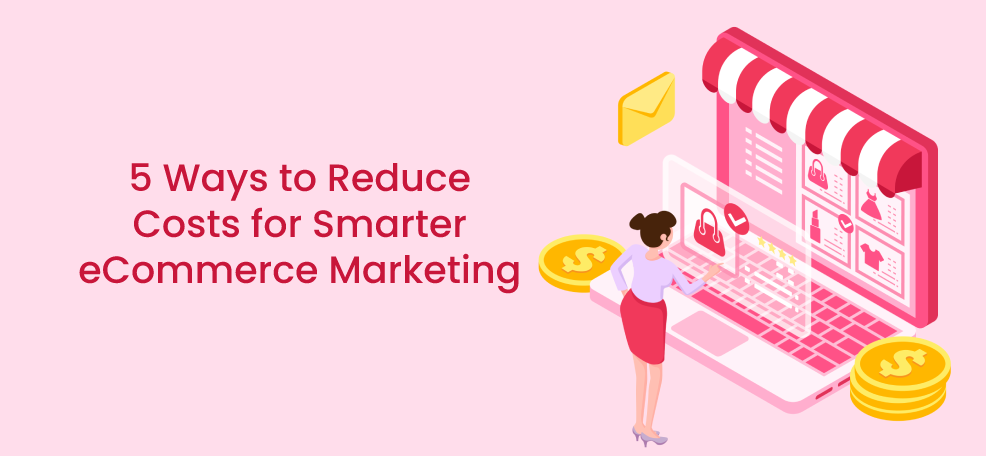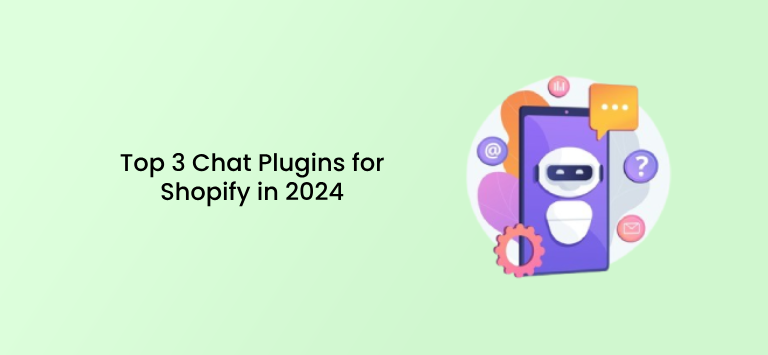There is an unhealthy tendency among some businesses that view eCommerce marketing as an expense, rather than an investment.
If you’re a startup or a small-to-medium enterprise (SME) and are thinking about brand growth —it’s essential to treat your marketing activities as an investment.
Speaking of marketing budgets, you must first have enough sufficient budgets for your marketing campaigns, in order to work towards a high return on investment (ROI).
For most marketers across all industries, including e-Commerce—balancing marketing budgets with its ROI is a huge hurdle. With data-driven planning and implementation across different marketing channels, you can achieve a high ROI.
Having a clear understanding of your potential customers and position in the markets you’re operating in is also essential.
The first step towards ensuring that your eCommerce marketing spending yields you higher ROI is to be aware of the specific marketing channels that lead to higher ROIs for your niche.
For instance, if you’re selling to consumers online, it doesn’t make sense to promote on LinkedIn, as most of your B2C consumers are instead on other social platforms, such as Facebook and Instagram.
Before deciding how to allocate your marketing budgets, you need to first know where your customers, what your goals are (your desired conversion event – is it a download, an email, or a sale), and how much you can afford to spend to get new customers (cost-per-acquisition, CPA).
Finding precise answers to these questions will help you gain insights into where and how to utilize your marketing budget efficiently and effectively.
Another thing worth mentioning is— you need to plan and test your marketing endeavours and strategies accordingly on a small scale, before scaling up your budgets.
Too often, businesses prematurely adjust their marketing budgets and channels based on inadequate data and metrics before deciding whether a channel is worth investing in.
This article will discuss five ways companies can get the most from their e-Commerce marketing budgets.
Let’s get started.
1. Create A Marketing Strategy And Utilize Built-In Marketing Tools That Fits Your Company Objectives
Before planning your e-Commerce marketing budget, you need to first understand your market positioning to plan the optimal approach to reach your target demographic.
If you’ve got a new, foreign (and yet exciting!) product to sell online, you need to understand how your potential customers will react and who these prospective customers are.
Create consumer profiles of your prospective targets, which includes:
- Their age group (are they boomers, Gen Z, or millennials?)
- The platforms they regularly use (are they Facebook aficionados or TikTokers?)
- Interests
- Geography
- Income levels
There are better and more effective ways to find customers, and your sales message will depend on their consumer profiles.
Depending on the markets you’re operating in, you might need to invest more in crafting marketing collateral that differentiate your business from your competitors and positions your brand in the minds of your key demographic.
In terms of budget allocation, most companies marketing budget accounts for 1% – 10% of their revenues. However, for many D2C startups looking for hypergrowth, marketing budgets can often account for between 20% to 40% of their revenues.
To understand your demographic better over time, you need to accumulate and embrace data using modern marketing automation tools, Instagram automation tools, or CRM software, which can be integrated with various social media channels like Messenger, WhatsApp, and Instagram.
The Chaty Shopify App allows you to chat with your website visitors via their favourite channels, answering any questions they might have in real-time and on their preferred channel. Integrate this alongside beautiful sticky contact forms to capture data and information on your customers.
Any e-Commerce company should partner with a hosting partner for their online stores that offer built-in marketing tools. These tools will only make your marketing efforts easy and efficient they will also save you money in the long run.
Once you have compared your top choice for an e-Commerce engine — be it the likes of Shopify or Squarespace — ensure that the offered built-in marketing tools help with your page rankings in SEO, provides you with comprehensive site data, and include a dashboard that enables you to easily manage your social media accounts in one place.
2. Enhance Your Branding Campaign With Marketing Materials
If you want your brand to thrive, it is essential to leave a lasting and positive impression on customers. Create royal logo and related professional marketing materials, and promote them on appropriate marketing channels, including social media.
You can distribute printed marketing materials at events and conferences. During product launches, you can offer freebies, promo codes, and in-person interviews.
These may sound slightly overwhelming, but such activities are among many other effective marketing strategies to turn prospects into loyal, lifelong customers.
Another effective marketing strategy to turn prospects into lifelong customers is to keep them happy—one great way to do it by rewarding them with loyalty programs.
See, the cost of acquiring new customers is higher than the cost of keeping your existing customers happy. This is why loyalty programs can be so valuable. So, think about repeat business while preparing your marketing strategy.
Companies like Premio can help you create promotional products that make your brand stand out.
With the Coupon X Shopify App, you can increase customer lifetime value by providing coupons to reduce cart abandonment. This nifty plugin also helps you create coupons, discounts, and promo codes and boost sales, increase cart value, and provide your customers with a unique shopping experience in Shopify.
3. Optimize Your Ecommerce Website for Search (SEO)
Modern consumers shop differently than most marketers are accustomed to. Many customers search for a product or service on Google or search for it on Facebook, Instagram, or Pinterest.
They also read comments and reviews about the products and services they’re looking for, which for a large part, impacts their buying decisions and behaviour.
This is why SEO, social media marketing, and a well-rounded digital presence have become extremely important.
Therefore, consider allocating part of your marketing budget to optimising your web presence.
Sure, most companies spend a considerable chunk of their budgets on acquiring new customers, but optimizing your website, content and improving the user experience will help get the most of your existing marketing strategies.
It doesn’t matter how good or well-thought your ads or marketing campaigns are; if a visitor goes to your eCommerce store and fails to find what they’re looking for or finds it challenging to navigate around the site to make a purchase — you’ll lose customers.
4. Utilize Facebook Ads Effectively With Lookalike Audiences
You can leverage Facebook Ads to market to targeted or general audiences. Facebook ads are comparable to Pay-Per-Click (PPC) ads such as Google Ads, but with Facebook, you can directly reach consumers who are potentially interested in your product. You can utilize Facebook dynamic ads to automatically show the right products to people who have expressed interest on your website, in your app or elsewhere on the internet.
In 2019, the average cost for PPC on Facebook was nearly $0.55 per click, which is $2 less than in 2018. This is good for companies thinking to get more leads.
Facebook Ads campaigns are helpful to build awareness surrounding your brand, attract traffic, and increase conversions. With Facebook, it is easy to set a fixed budget for your marketing campaign and tweak the parameters enabling the target to the correct demographic you want.
What makes Facebook Ads even more cost-effective is its strong targeting features. One such feature is the “Lookalike Audience”.
Lookalike Audiences on Facebook are created based on data from your Facebook pixel, which allows you to build new pools of people to market to based on your existing customers.
For example, if you have 1,000 customers who have reached your checkout page and ordered a product, you can use the Lookalike Audience feature to allow Facebook to extrapolate from that 1,000 customers into 1,000,000 prospective customers who are alike to that first 1,000.
There is a misconception for companies exploring social media for marketing purposes to grow their business has to be on every single platform — Facebook, Instagram, Pinterest, Twitter, Tumblr, to LinkedIn.
If you’re first starting out, select a few social media platforms that you think your demographic will be in, and begin posting updates using social media tools like Hootsuite.
You can also hire a small content marketing agency or a freelance staff to handle updates for around $1,000 – 2,500 a month.
5. Leverage User-Generated Content (UGC) That Delivers Value and Engages Customers
Many modern consumers have lost trust in traditional advertising campaigns, and better respond to content that delivers value and engages them in a more authentic way. One way to do this is to use user-generated content in your content marketing strategy.
Authenticity is key in today’s times, and UGC can help keep your brand feeling authentic and trustworthy. Because UGC is created by real people – and not a marketing team – these content and endorsements of your business can feel more genuine.
UGC is also a great way to keep marketing costs low, by engaging your best customers to create your visual content for you. By sourcing content directly from your fans, you can employ this authentic content on your social media channels.
Brands have reported up to 28% increase in brand engagement from UGC as compared to traditional content.
Conclusion
The actual cost of e-Commerce marketing depends on many variables, but ultimately it all boils down to your total revenue. The higher your revenues, the more funds you can allocate for your marketing campaigns, driving you towards growth and success.
Author’s Bio
Jaron Soh is Co-founder and COO at Traktion, the platform that makes hiring for growth simpler, agile, and more profitable for businesses. Prior to Traktion, Jaron founded the e-commerce marketplace Artisan & Fox, with operations across 10+ countries.









